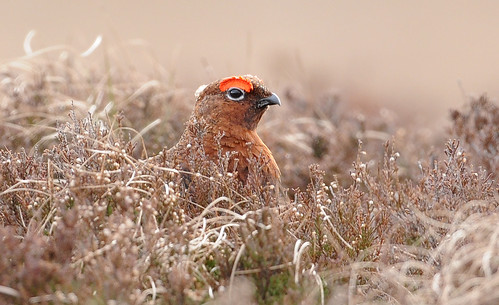The Short List.
On a rare Saturdays birding for me and a good day weather-wise I couldn't resist giving Clougha/Birk Bank a 'going over' to see if it could offer me any surprises. Well it did....at c.400m and two hours into the visit I found a lone male Stonechat, but despite keeping my eyes on the bird and its immediate surroundings for fifteen minutes I found no other bird/s with it. Also of note, 5 Raven, at least 14 Red Grouse, 8 Meadow Pipit, a juvenile Wheatear, 2 Wren, and - taking into account the risk of duplicate counting - up to 8 Kestrel seen.
Meadow Pipit. Phil Slade
It isn't really all that long ago that I would have steered clear of ever going up and onto the moorlands having never been attracted to what I used to refer to as dull places void of birds in particular during the winter months. If you do visit the moorlands in winter you'll probably end up being dismayed at the lack of birds, and its perfectly possible you'll see almost nothing for hours on end. But the key to any birding - and particularly moorland birding - is patience, and there are one or two moorland birds up there which I'm quite attracted to, and in a brief season during the summer months the moorlands are in fact quite rich in bird life.
During the summer the bird you are likely to encounter most is the Meadow Pipit, a bird with the serious misfortune of always being on the agenda of the Merlin and its next meal, this bird of prey is my most favourite one and - along with another moorland bird the magnificent Hen Harrier - takes the Meadow Pipit by the hundred at this time of the year on their daily hunts for food. Not surprising then, the Meadow Pipit is a bird that I see as one with little ability to deal with a crisis, immediately it sees you it will go into panic mode fluttering up into the air whilst blurting out its series of sip, sip calls, flies this way and that way, giving the impression of never really knowing what to do or where to go next, but eventually dives into cover on the ground and in all possibility won't then calm down for some time to come. So, if you're a small moorland bird you really only have two options for survival, you either skulk all day long in the heather, or venture out and stay on guard, but not many birds are up to this latter strategy, but I know one that is, and I happen know it very well....

Female Stonechat Brian Rafferty
The Stonechat has the habit of 'sitting' on elevated perches the reason being, it can scan the ground below for the movement of small insects to pounce on. For a small bird the Stonechat has large eyes which I reckon are capable of spotting a Merlin from a mile away and probably only falls victim to one very rarely. The other birds take advantage of this little beauty and its ability and willingness to stand guard whilst they live their lives knowing that if danger is imminent the Stonechat will give them the warning to take the cover needed to escape.
Red Grouse Brian Rafferty
Another moorland specialist is the Red Grouse, this is the bird that often surrounds me on my regular visits to Clougha which is a stronghold of the species where I've counted in excess of forty birds on one occasion during a five hour visit here. Not liking my approach, they 'chuckle' away at me as they fly off, they are a bird whose ecology is so tangled up with heather that it is actually heather-coloured itself.
So, as opposed to about twelve years ago plus my knowledge that the Stonechat is now always present on our moorlands in Bowland - though much declined and absent in many areas - since the past two harsh winters - I always enjoy my regular wanders into the areas I once dismissed as bird-less and boring places to find the birds mentioned here plus the excitement of hopefully finding yet another of my favourites the declining....
Note once again the excellent photographs on Birds2blog, with many thanks to PS/BR/DC.



The Moorland might nt be as busy with birds as a lowland wood Pete, but boy does it hold some special birds :-)
ReplyDeleteSwap you one for a Turtle Dove Warren!
ReplyDeleteBrilliant post, I've just identified a meadow pippet from this, after seeing lots of birds, noisy, and doing just what you described. Thanks.
ReplyDelete